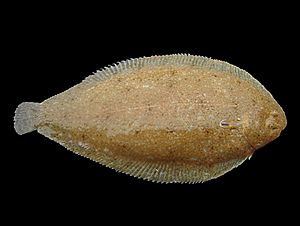Soles facts for kids
Quick facts for kids Soles |
|
|---|---|
 |
|
| Sand sole, Pegusa lascaris | |
| Scientific classification |
|
| Kingdom: | Animalia |
| Phylum: | Chordata |
| Class: | Actinopterygii |
| Order: | Pleuronectiformes |
| Family: | Soleidae Bonaparte, 1832 |
| Genera | |
|
Achiroides |
|
The true soles are a group of fish known as Soleidae. They are a type of flatfish, which means their bodies are very flat. These fish live in saltwater oceans, and some can even be found in brackish water (a mix of fresh and salt water). You can find them in the East Atlantic, Indian Ocean, and parts of the Pacific Ocean. Some true soles also live in fresh rivers and lakes in Africa, southern Asia, New Guinea, and Australia.
Soles are bottom-dwelling fish. This means they spend their lives on the sea floor. They usually eat small crustaceans like tiny crabs or shrimp, and other small creatures without backbones, called invertebrates. There are about 180 different kinds of true soles, grouped into 30 different genera.
Where Soles Live
True soles live in many different watery places around the world. Most of them live in the ocean. They are found in the Atlantic Ocean, the Indian Ocean, and the western and central parts of the Pacific Ocean.
Some soles also live in fresh water. These freshwater soles are found in countries in Africa, southern Asia, and even in New Guinea and Australia.
In the past, some soles found in North and South America were thought to be true soles. However, scientists later decided they were different. These American soles now belong to their own family called the American soles (Achiridae). Only one true sole, Aseraggodes herrei, is still found near the Galápagos and Cocos Island in that region.
How Soles Grow
Soles have a very interesting way of growing up. When they are born, they start as tiny larvae. At this stage, they look like most other fish. They have an eye on each side of their head, just like you do. This is called being bilaterally symmetric.
But as a sole grows, something amazing happens. One of its eyes, usually the left one, slowly moves! It travels around the top of the head until it ends up on the right side. So, adult soles have both eyes on one side of their head.
Once they are grown, adult soles lie flat on the sea floor. They usually rest on their blind (left) side. Their dark colors and flat shape help them blend in with the mud or sand. This makes them very hard for other animals to spot.
Soles as Food
Many types of soles are important for people to eat. They are caught and sold as seafood around the world.
One very popular type is the common sole, known as Solea solea. This fish is a favorite food in northern Europe and around the Mediterranean Sea.
Images for kids
-
Solenette, Buglossidium luteum
See also
 In Spanish: Soleidae para niños
In Spanish: Soleidae para niños




